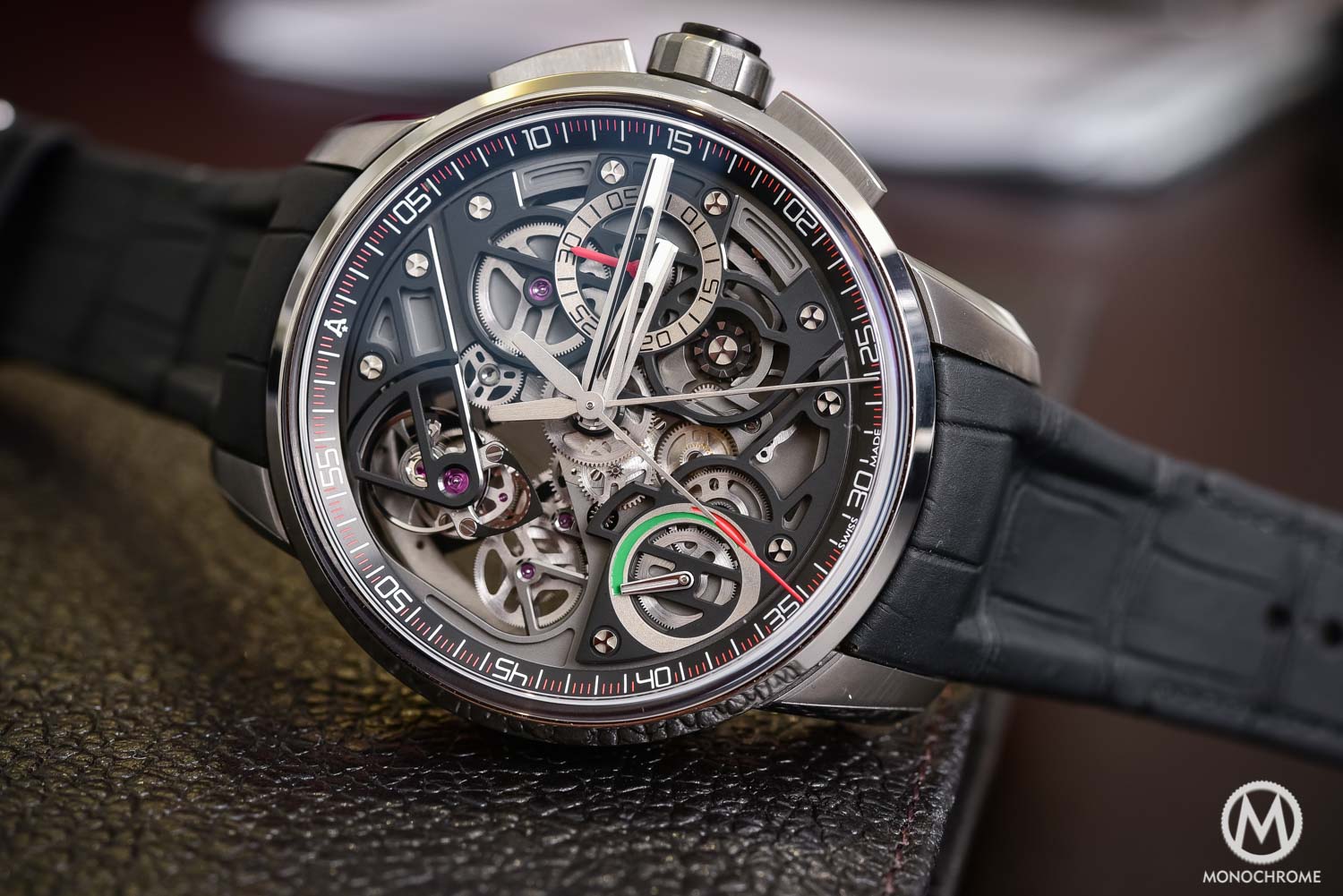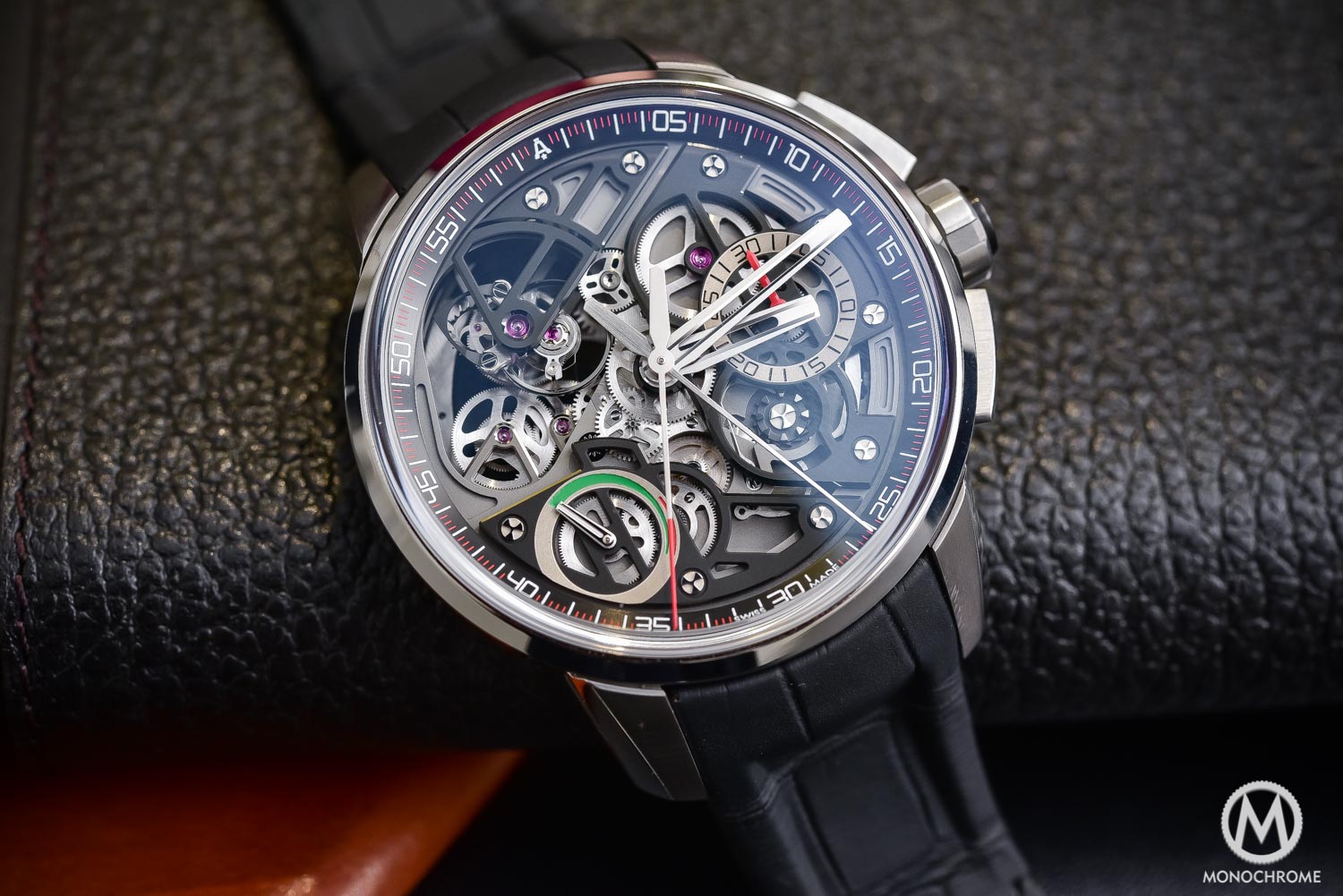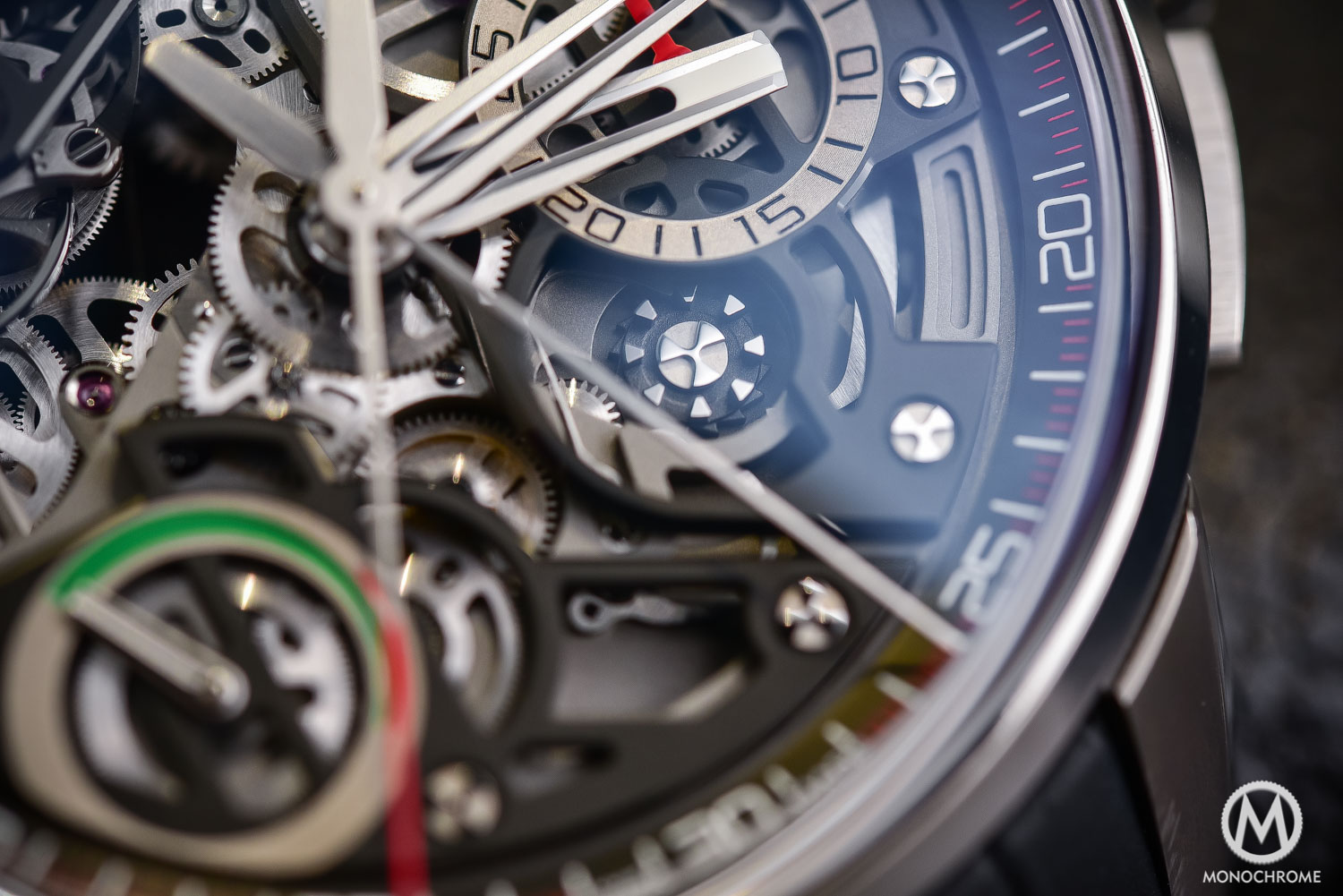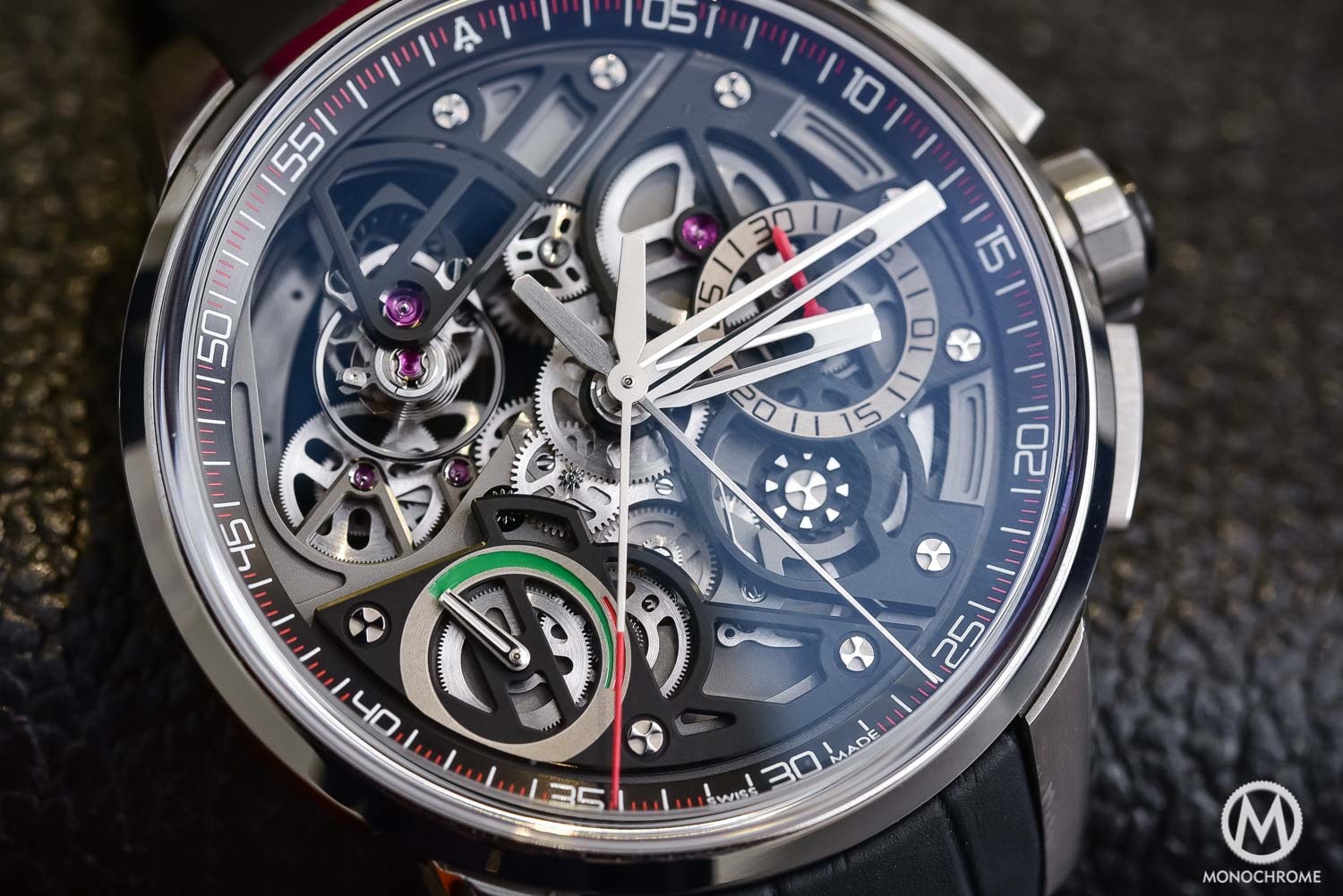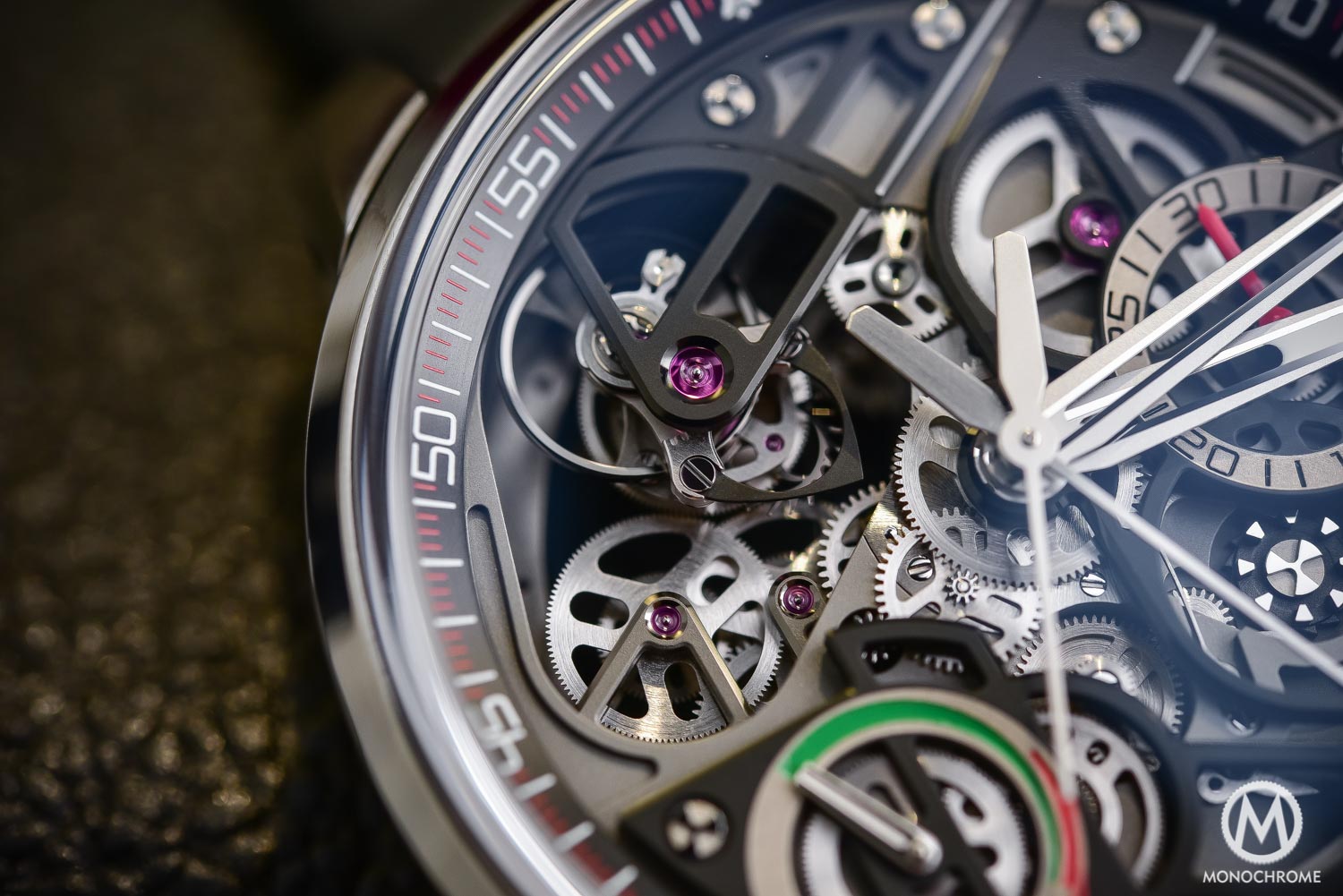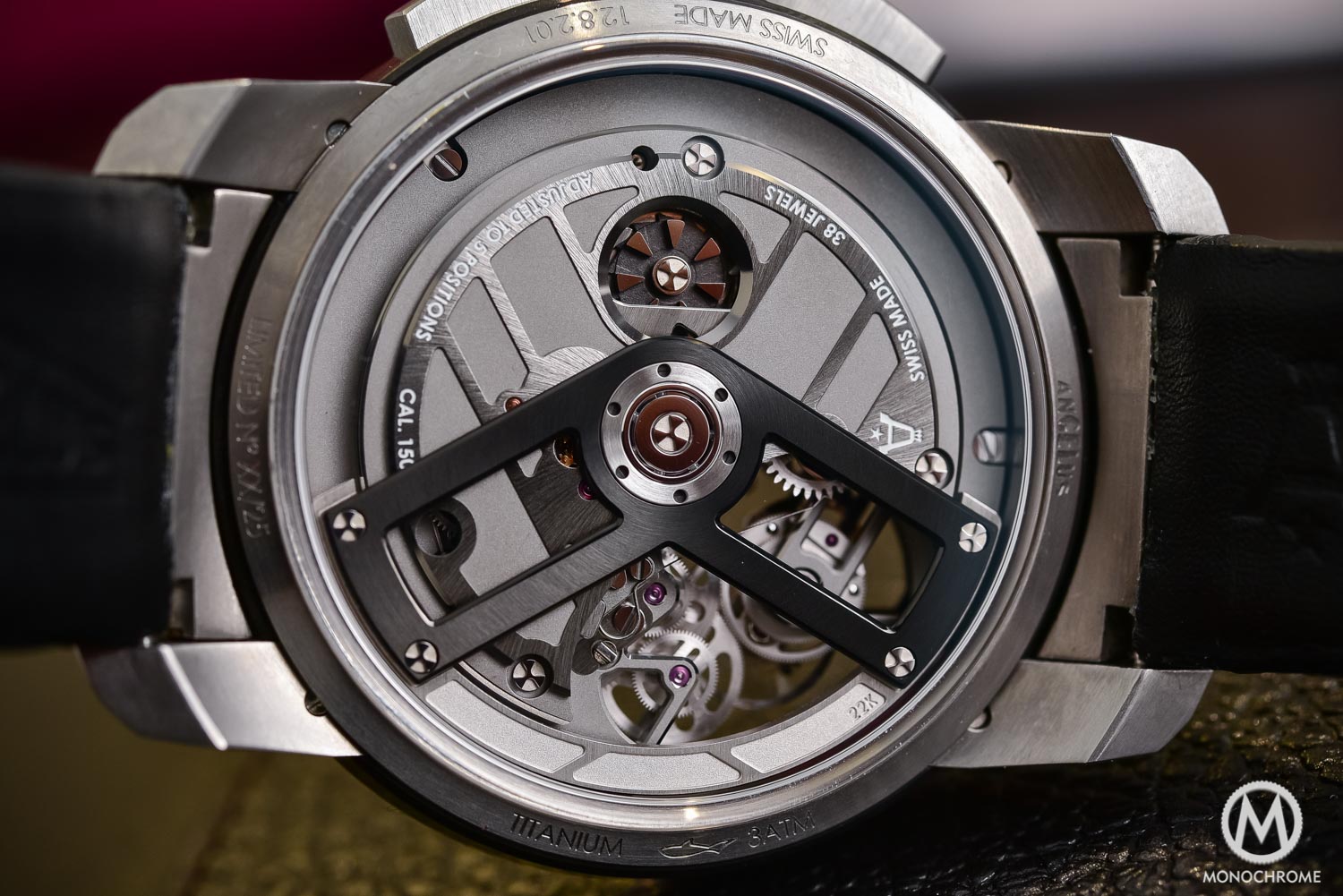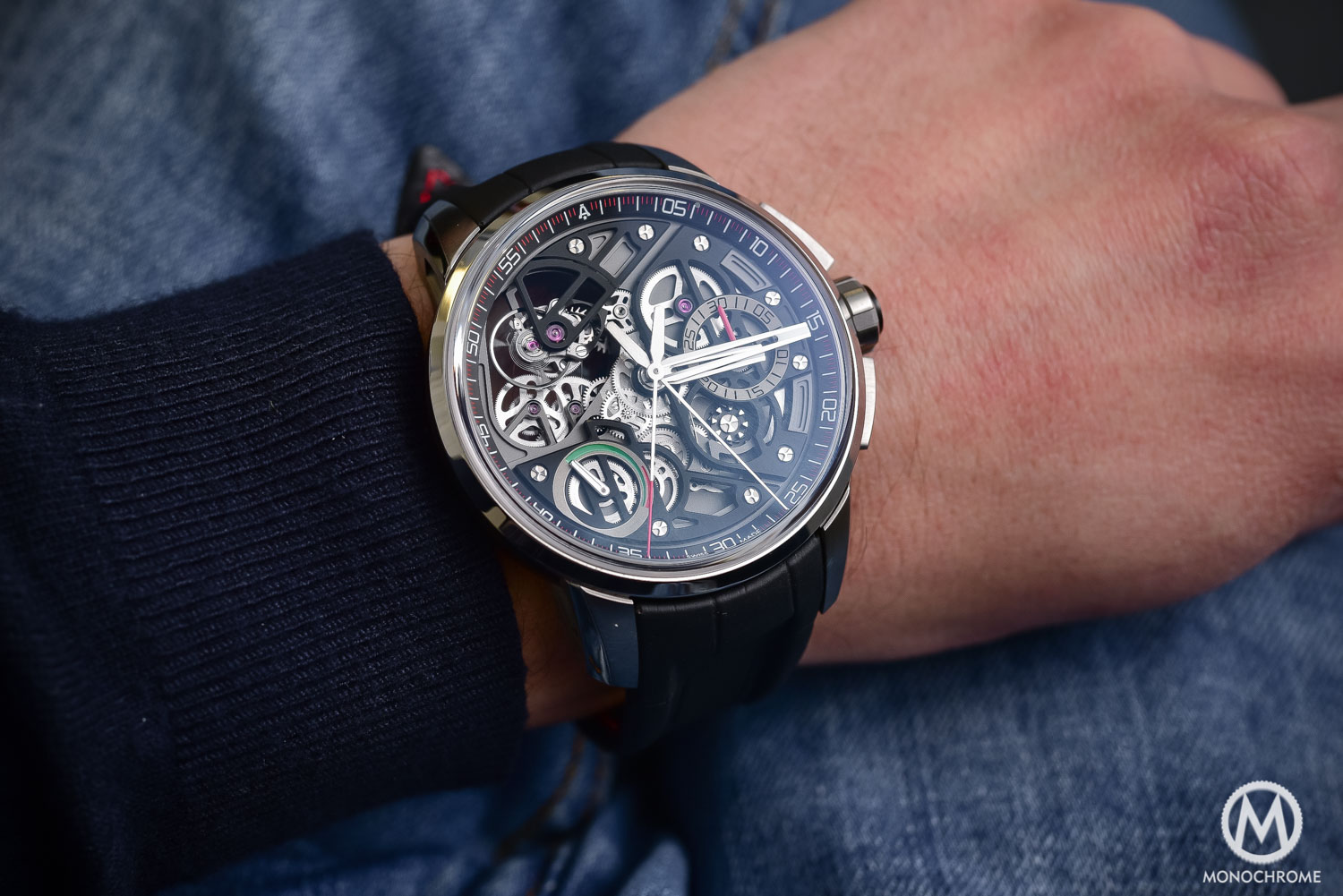Hands-on with the Hyper-Technical Angelus U30 Tourbillon Rattrapante (and how can it be, relatively speaking, so affordable)
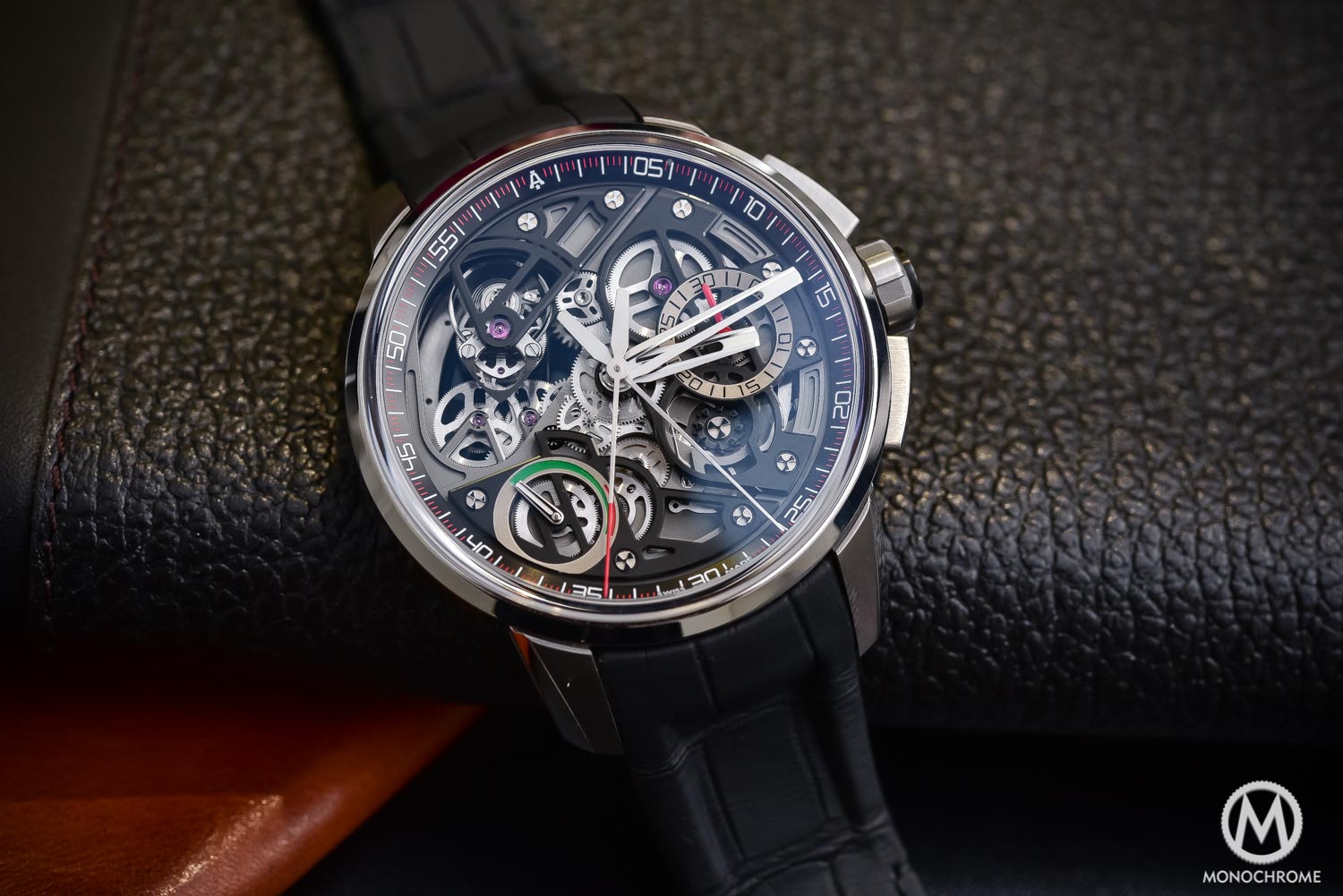
Listen to this: double column-wheel, flyback, split-seconds, automatic chronograph, skeletonized, and with a tourbillon… Sounds like something we’re all dreaming off. It’s like the Lamborghini you had on your wall when you were a teenager. Something that looked too good to be true? Or just way too expensive to ever be accessible, even for someone in a ‘healthy’ income? Well, it seems that Angelus Watches does not agree, as they have such a watch in their catalogue. It is named the Angelus U30 Tourbillon Rattrapante and we’re going to look closely at it – and try to understand how it can be, relatively speaking, so affordable.
Let’s get things clear from the beginning. When you have the idea of a split-second chronograph with tourbillon in mind, the psychological price you can think of is certainly six figures – and probably several hundred thousands. One way or another, it’s unthinkable that the price will be below the 100,000 Swiss Francs / Euros / Dollars frontier. In fact, when you look at potential competitors, it is quite hard to find one. A split-seconds chronograph with tourbillon… We have the Richard Mille RM 008 or the RM 50-02 – both priced way over 500,000 CHF (in fact, over 1,000,000 CHF for the latter). We can think of the Blancpain Leman Tourbillon Split Second Chronograph, but it is discontinued and was price way over 100,000 CHF. The Bulgari / Daniel Roth Tourbillon Rattrapante…? Well, it is also discontinued and certainly very expensive too. Finally, there’s the Montblanc Villeret 1858 ExoTourbillon Rattrapante, which will cost you around 250,000 CHF (OK, we have to say that the hand-finishing is really superb).
Why looking at these competitors? Simply because the Angelus U30 Tourbillon Rattrapante has the same complications – and certainly more, because it is also an automatic, fully integrated split-seconds chronograph and skeletonized – for a price that is almost impossible to comprehend: 55,600 CHF (before taxes). If you look closely, that’s the price of a simple tourbillon (in gold though) from Jaeger-LeCoultre (Master Date Tourbillon 39) or from IWC (Portugieser Tourbillon Hand-Wound) – two watches with only a tourbillon as complication and far from being haute-horlogerie or entirely hand-finished. So, what we have here with the Angelus U30 Tourbillon Rattrapante is simply mind-blowing in terms of price, but also and mainly in terms of technical content.
The Angelus U30, a split-seconds chronograph with Flyback
Alone, this would already be a very interesting watch. Combining the rattrapante function and the flyback, all of that actuated by two column-wheels, is one the finest combinations possible for a chronograph. Actually, there’s not many of such watches on the market. The Angelus U30 Tourbillon Rattrapante is rare, thus highly desirable, and technically complex. In fact, it is the most complex watch produced by Angelus (the others are the U10, the U20 and the U40) – whether we think about the recent years or the old days of Angelus. The brand never had such a watch in the collection.
First of all, the sequence to start a timing session is controlled by a column-wheel. For the moment, this is a classical 2-pushers chronograph – one at 2 starting and pausing the timing session, one at 4 to reset the chronograph. Then, add to that the split-seconds / rattrapante (in French) function. This function allows the timing of different events that begin but do not end together, for example the times of two runners. Two separate chronograph second hands are set one over the other; the one underneath is the split-seconds hand. When the chronograph is started, both hands start moving in lockstep together, until a press of the pusher in the crown “splits” them, with the top hand continuing and the bottom split- seconds hand stopping to allow an intermediate time to be noted. By again pressing the pusher, the split-seconds hand will instantly catch up to the main chronograph hand, ready again to record a new intermediate time.
Related to this function is a second column-wheel, this time visible on the dial-side, a pair of clamps that control the split-second wheel (they close or open on request, when pushing the split-second function and are released by the second column-wheel), of course a series of levers and gears and finally a third pusher, which is placed into the crown at 3. The split-seconds / rattrapante function is complex, mainly because it adds moving parts to a complication already hard to master, the chronograph. A chronograph is sensitive, hard to adjust and mechanically complex (probably more than a tourbillon). A split-second is even more complex to develop and assemble.
The latest function linked to the chronograph is a flyback. Combined this to the rattrapante and you have a really complex mechanism. The flyback or retour-en-vol in French was developed in order to allow pilots to time several events in a row. While most chronographs have a start-stop-reset sequence – meaning the need to press the buttons 3 times to stop and start a new timing session again – a flyback will allow doing this sequence in one single push on the button at 4. The flyback function is particularly complicated to achieve when combined with the split-seconds as the flyback mechanism has not one, but two central chronograph hands to reset and restart. In addition, the forces generated on the split-seconds mechanism during the instantaneous reset and restart are significant. Therefore, all of the different chronograph functions have to be painstakingly set and optimized by the watchmaker during assembly, in order to guarantee smooth operation of all functions.
The latest function that is linked to the chronograph is the 30-minute counter, placed directly on the movement – this is a chapter ring attached to a bridge of the movement. As the rest of the watch, it is also rather complex, as linked to the flyback function. The only delicacy that this watch doesn’t have is the split-function on the minute counter (like in the Double-Split from Lange), but honestly, we’re just being picky here. All the functions linked to the chronograph in the Angelus U30 Tourbillon Rattrapante are just insanely impressive, complex and the best comes from the feeling when used: smooth, strong enough with a lot of interaction when pushing the buttons, and a reassuring feel of reliability – which considering the amount of technology was certainly not easy to achieve.
The Angelus U30, an automatic tourbillon
As if it was not enough, Angelus and his mastermind Sébastien Chaulmontet added a tourbillon and an automatic winding to this flyback, double column-wheel, split-seconds chronograph watch (sorry, I just love writing this sequence of words…). Indeed, in an opening between 9 and 11 sits a traditional one-minute tourbillon, which serves as regulating organ for the whole movement. While it can’t be used as a small second indicator (no second track), it will give a nice running indication and will enliven this dial when the chronograph is not running. Furthermore, continuing to play on the high-tech side, the Angelus U30 features a fast-beating tourbillon, cadenced at 4Hz (28,800 beats per hour), instead of the traditional 3Hz used in tourbillon watches. On paper and if the watch is correctly adjusted by the watchmaker (and we have no doubt about it here), this will be beneficial to the accuracy of the whole watch and its chronograph mechanism (the faster an escapement beats, the most precise it will be – theoretically).
The tourbillon cage of the Angelus U30 is entirely made of non-magnetic material and reduced to the maximum to further minimize mass and optimize performance. The entire mechanism of the regulating organ, including the tourbillon cage, the balance wheel and the escapement, as well as all the gears and pinions that link it to the rest of the movement can be seen here – and same goes on the movement side. On these photos below, we can also observe the power reserve indictor, which, like the 30-minute counter, is directly attached to the movement and with its gears and wheels visible. It will provide an instinctive display: a green sector indicates ideal torque while red highlights that it’s time to wind the watch. The Angelus U30 has a power reserve of 45 hours, however linked to a comfortable automatic winding.
As a proof of the modernity and technical wish wanted by Angelus, the U30 Tourbillon Rattrapante is based on a modern integrated and automatic movement – something that is also attested by the 4Hz frequency. First of all, this movement is fully integrated, with a modern architecture – we’re not talking about a standard 3-hand movement on top of which a tourbillon and split-second chronograph have been added. This integrated architecture is particularly visible on the back, where the bridges are rather plain and hide most of the chronograph parts, to the exception of the main column-wheel. Such a structure will definitely help a better interaction of parts, which have been conceived from the beginning to work together in harmony, and thus better performance and reliability. Then, this movement relies on an automatic winding, again a proof of its modernity. While the power reserve is quite short – 45 hours when the chronograph is not engaged – the automatic winding will make it comfortable.
What about the look of the Angelus U30 Tourbillon Rattrapante
Its movement is properly technical and complex, and so is the look of the Angelus U30 Tourbillon Rattrapante. The tourbillon / split-seconds calibre is house in a 47mm case, crafted in grade 5 titanium – which of course helps the resistance, lightness and the price (compared to gold). The case is sporty, large and angular. However, besides its imposing size, this watch sits relatively well on the wrist (as you can attest on the photo below, even on my small 16.5cm wrist). The lugs are highly curved and the watch definitely feels balanced. The strap, made in alligator skin, is structured and formed, to complement this sporty design.
The most eye-catching part remains of course the dial / movement, which is entirely opened and layered, to observe the several complications. All of them are easily identifiable, from the tourbillon, the power reserve and the split-seconds area. It is clear that this movement has been purposefully build to feel structured and opened. In this relative mess, with more than 15 wheels visible on the dial side, this calibre A-150 is in fact very organized, with a deliberate symmetry and bridges shaped to look like the “A” of Angelus.
As for the finishing, there’s also a strong wish of modernity and technicality, which doesn’t mean that decoration was forgotten. Plates and bridges are sand-blasted, with a grey NAC-coating on the main-plate and a black PVD-coating on the bridges, to emphasize contrast between these parts but also to create contrast with the shiny polished chamfers. Indeed, all of them are bevelled and polished. In fact, all the parts of the Angelus U30 Tourbillon Rattrapante are decorated, even the non-visible ones. The mass of the rotor is 22k gold, the column-wheels are black coated and then mirror-polished on some areas. All the wheels are specific to Angelus, with a 6-spoke design. Same goes for the tiniest screws… It is haute horlogerie, in a more modern way.
How can the Angelus U30 Tourbillon Rattrapante be, relatively speaking, so affordable?
Right at the beginning of this article, we made comparisons, which need to be slightly nuanced. Of course, the Richard Mille RM50-02 has probably an advantage in terms of materials (the usual high-tech RM components) and finishing, which might be even more complex and require even more hours of work. Same goes for the Montblanc Villeret 1858 ExoTourbillon Rattrapante, which is a proper lesson of old-school, traditional hand-decoration (the tourbillon bridge alone is a piece of art). However, how can we justify a price 4 times to almost 20 times higher, for comparable (not the same but “the same kind of”) technologies? – remember that the 3 watches we’re talking about feature a one-minute tourbillon and a split-seconds chronograph.
Sébastien Chaulmontet, the mastermind behind Angelus and Arnold & Son
Like always, in such case, “it is better to talk to the organ-grinder than to the monkey“… So we asked the question straight to Sébastien Chaulmontet, head of Angelus. How is that possible to have a one-minute tourbillon, a fly-back double column wheel chronograph, a split-seconds (rattrapante), a self-winding mechanism and a power reserve indicator in a watch that retails for 55,600 CHF (before taxes)? Yes, there’s no typo…
- Angelus is part of La Joux-Perret, an entirely integrated manufacture, which can produce parts to a relatively low price, considering the absence of sub-contractors and suppliers. No need to add the margins of suppliers who manufacture parts for you. All is done in-house, from the 3D conception, to the machining, the control and the finishing of the parts… Economies of scale.
- The overheads are lower than some of the larger brands and split between Angelus, Arnold & Son and La Joux-Perret (which produced parts for others).
- Marketing and communication costs are low. Marketing is centered on the product and not deployed to sponsor some events or celebrities. This has a strong effect on the final price.
- The movement being entirely integrated and conceived from the beginning to be a tourbillon / split-seconds, Sébastien and his teams have been working from the beginning to facilitate its assembly, to gain time on this usually costly work station.
- The latest explanation is an overall low margin on the product. First, Angelus is a recent company, which needs to gain in popularity. Then, Sébastien wanted to offer this extreme watch for a relatively low price. This can explain why you can have a split-seconds chronograph with tourbillon for the price of a tourbillon-only from a mainstream brand
This watch, that our Editor-in-Chief Frank dared to call a “proper bargain”, is certainly one of the best price/pleasure ratios of the year. In a market that tends to be overpriced, we are usually enthusiastic when we feel like we are paying the right price (and that’s not so common in this industry). Here, you’ll feel like you have triple of what you paid. It is just impressive – and here we are talking of the whole package… Be fast, only 25 pieces will be produced.
Specifications of the Angelus U30 Tourbillon Rattrapante
- Case: 47mm diameter x 15mm height – polished and brushed grade 5 titanium – sapphire crystal on the front and on the back – 30m water resistant
- Movement: Calibre A-150, in-house – automatic winding – 45h power reserve – 28,800 vibrations/h – Hours and minutes, split-seconds flyback chronograph, one-minute tourbillon, power reserve indicator
- Strap: Black stealth alligator with titanium insert or rubber on Titanium folding buckle

